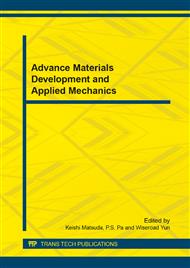p.63
p.72
p.78
p.84
p.89
p.95
p.99
p.103
p.109
The Effect of Guide Sleeves on Shear Behavior of 3D Weaving Composites
Abstract:
In this study, guide sleeves are brought into 3D weaving composite preforms. The process vacuum assisted resin infusion (VARI) was used to fabricate the 3D weaving composite with guide sleeves. The load-deflection curves and shear behaviors of the 3D weaving composites with guide sleeves were obtained by means of the 3-point bending test. The fracture micrographs of the materials were studied by SEM. The effects of guide sleeves’ diameter and interval on the shear behavior and fracture mechanisms of the 3D weaving composites were analyzed. The results showed that the guide sleeves could prevent delamination effectively by bridging fiber layer and pinning crack extending along the fiber layer. Fracture toughness of the composite parts increase because of deformation, fracture of guide sleeves and debonding of interface. The diameter and interval of guide sleeves is smaller, which means the volume fraction of guide sleeves is higher, the interlaminar shear strength higher for the bridging is stronger.
Info:
Periodical:
Pages:
89-94
Citation:
Online since:
July 2014
Authors:
Price:
Сopyright:
© 2014 Trans Tech Publications Ltd. All Rights Reserved
Share:
Citation:


